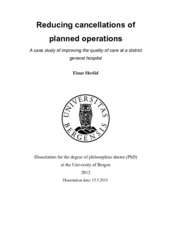| dc.contributor.author | Hovlid, Einar | en_US |
| dc.date.accessioned | 2013-09-13T13:27:56Z | |
| dc.date.available | 2013-09-13T13:27:56Z | |
| dc.date.issued | 2013-05-15 | eng |
| dc.identifier.isbn | 978-82-308-2279-1 | en_US |
| dc.identifier.uri | https://hdl.handle.net/1956/7173 | |
| dc.description.abstract | Background: Cancellations of planned surgeries are a well-recognized quality problem in healthcare. They harm patients and waste resources, leading to increased healthcare costs and undermining patient-centered care that is one of the core values of healthcare. Previous research on interventions to reduce cancellations has mainly addressed earlier and improved preoperative assessment as means to reduce cancellations and assessed outcomes from a management perspective (i.e., by focusing on costs, length of stay, improved efficiency, and reduced postoperative complications). Førde Hospital had experienced high cancellation rates and decided to redesign the clinical pathway for elective surgery to reduce cancellations, increase efficiency, and make care more patient-centered. In this dissertation, I use different perspectives to assess whether and how the interventions affected the quality of care. I also explore how contextual factors affected the outcomes and factors that contributed to sustained improvements. Material and methods: Together with my advisors, I conducted a case study with quantitative and qualitative data. The case was Førde Hospital’s project for redesigning their clinical pathway for elective surgery. We interviewed employees to explore how the pathway was redesigned, the impact of contextual factors, and the factors that contributed to sustained improvements. To assess the effect of the interventions, we collected the number of planned, performed, and cancelled operations from the patient administrative system. We interviewed patients to study how they experienced the changes. We used Student’s t-test to compare cancellation rates before and after the intervention and statistical process control to assess whether the improvements coincided with the interventions and whether the improvements were sustained. We performed a content analysis of the interview data and related the findings to theoretical frameworks. Findings: The mean cancellation rate was reduced from 8.5% to 4.9% (95% CI for mean reduction, 2.6-4.5; p < 0.001) after the interventions. The median number of operations performed per month increased from 323 to 378 (p = 0.04). The improvements coincided with the interventions and were sustained more than 2 years after the interventions. According to the patients, the pathway was changed in a way that responded to their wants and needs; thus, care became more patient-centered. The expedient use of information technology and sufficient time to rework the clinical processes, together with the improvement strategy, were important contextual factors that influenced the success of the project. The core element of the strategy was improvement through the involvement of clinicians in changing the clinical system. Changes should equally address client quality, professional quality, and management quality. These overall objectives were further operationalized into clinical problems to which the clinicians could relate. The clinicians improved their understanding of the clinical system and its interdependencies during the course of the improvement project. This new understanding contributed to sustained improvements by influencing important stages of the improvement process. It influenced how they inquired about the quality problems, how they developed interventions, and how they adapted interventions to their context. Conclusion: The changes that were made to the pathway for elective surgery contributed to improvements in the quality of care. Care became more efficient, timely, and patientcentered. Clinicians’ new understanding of their clinical system represented a new mental model that was shared at the organizational level. This new mental model induced changes in organizational behavior; hence, double-loop learning occurred. Changes that originate from double-loop learning are more likely to be sustained because deeper structural elements are changed. The new understanding contributed to an enhancement of the clinicians’ understanding of the underlying causes of cancellations and made them more able to plan and implement interventions in alignment with the complexity of the problems. Furthermore, the new understanding enhanced their ability to adapt interventions to their context. The improvement strategy provided the clinicians with a holistic framework for their approach to quality improvement. Hence, they were able to achieve synergy in their improvements by implementing a set of interventions that simultaneously improved efficiency and patient centeredness. | en_US |
| dc.language.iso | eng | eng |
| dc.publisher | The University of Bergen | eng |
| dc.relation.haspart | Paper 1: Hovlid, E., Bukve, O., Haug, K., Aslaksen, A., & von Plessen, C. (2012). A new pathway for elective surgery to reduce cancellation rates. BMC Health Services Research, 12(1), 154. Article available at: <a href="http://hdl.handle.net/1956/6604" target="blank">http://hdl.handle.net/1956/6604</a> | en_US |
| dc.relation.haspart | Paper 2: Hovlid, E., von Plessen, C., Haug, K., Aslaksen, A., & Bukve, O. (2013). Patient experiences with interventions to reduce surgery cancellations. BMC Surgery, 13(1), 30. Article available at: <a href="http://hdl.handle.net/1956/7172" target="blank"> http://hdl.handle.net/1956/7172</a> | en_US |
| dc.relation.haspart | Paper 3: Hovlid, E., Bukve, O., Haug, K., Aslaksen, A. B., & von Plessen, C. (2012). Sustainability of healthcare improvement: what can we learn from learning theory? BMC Health Services Research, 12(1), 235. Article available at: <a href="http://hdl.handle.net/1956/6473" target="blank">http://hdl.handle.net/1956/6473</a> | en_US |
| dc.title | Reducing cancellations of planned operations. A case study of improving the quality of care at a district general hospital | en_US |
| dc.type | Doctoral thesis | |
| dc.rights.holder | Copyright the author. All rights reserved | |
